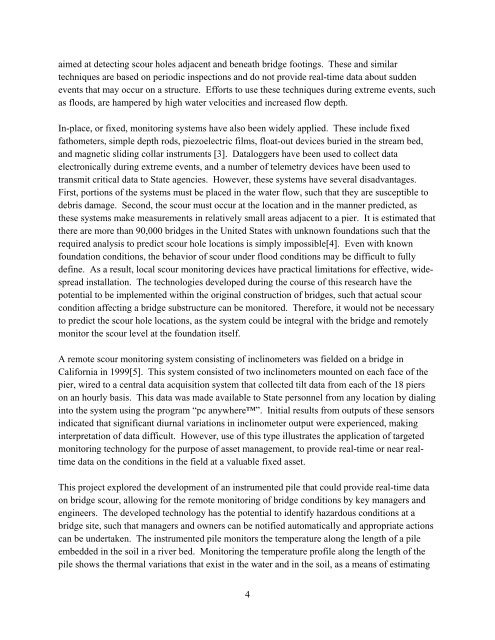Remote Health Monitoring for Asset Management
Remote Health Monitoring for Asset Management
Remote Health Monitoring for Asset Management
You also want an ePaper? Increase the reach of your titles
YUMPU automatically turns print PDFs into web optimized ePapers that Google loves.
aimed at detecting scour holes adjacent and beneath bridge footings. These and similar<br />
techniques are based on periodic inspections and do not provide real-time data about sudden<br />
events that may occur on a structure. Ef<strong>for</strong>ts to use these techniques during extreme events, such<br />
as floods, are hampered by high water velocities and increased flow depth.<br />
In-place, or fixed, monitoring systems have also been widely applied. These include fixed<br />
fathometers, simple depth rods, piezoelectric films, float-out devices buried in the stream bed,<br />
and magnetic sliding collar instruments [3]. Dataloggers have been used to collect data<br />
electronically during extreme events, and a number of telemetry devices have been used to<br />
transmit critical data to State agencies. However, these systems have several disadvantages.<br />
First, portions of the systems must be placed in the water flow, such that they are susceptible to<br />
debris damage. Second, the scour must occur at the location and in the manner predicted, as<br />
these systems make measurements in relatively small areas adjacent to a pier. It is estimated that<br />
there are more than 90,000 bridges in the United States with unknown foundations such that the<br />
required analysis to predict scour hole locations is simply impossible[4]. Even with known<br />
foundation conditions, the behavior of scour under flood conditions may be difficult to fully<br />
define. As a result, local scour monitoring devices have practical limitations <strong>for</strong> effective, widespread<br />
installation. The technologies developed during the course of this research have the<br />
potential to be implemented within the original construction of bridges, such that actual scour<br />
condition affecting a bridge substructure can be monitored. There<strong>for</strong>e, it would not be necessary<br />
to predict the scour hole locations, as the system could be integral with the bridge and remotely<br />
monitor the scour level at the foundation itself.<br />
A remote scour monitoring system consisting of inclinometers was fielded on a bridge in<br />
Cali<strong>for</strong>nia in 1999[5]. This system consisted of two inclinometers mounted on each face of the<br />
pier, wired to a central data acquisition system that collected tilt data from each of the 18 piers<br />
on an hourly basis. This data was made available to State personnel from any location by dialing<br />
into the system using the program “pc anywhere”. Initial results from outputs of these sensors<br />
indicated that significant diurnal variations in inclinometer output were experienced, making<br />
interpretation of data difficult. However, use of this type illustrates the application of targeted<br />
monitoring technology <strong>for</strong> the purpose of asset management, to provide real-time or near realtime<br />
data on the conditions in the field at a valuable fixed asset.<br />
This project explored the development of an instrumented pile that could provide real-time data<br />
on bridge scour, allowing <strong>for</strong> the remote monitoring of bridge conditions by key managers and<br />
engineers. The developed technology has the potential to identify hazardous conditions at a<br />
bridge site, such that managers and owners can be notified automatically and appropriate actions<br />
can be undertaken. The instrumented pile monitors the temperature along the length of a pile<br />
embedded in the soil in a river bed. <strong>Monitoring</strong> the temperature profile along the length of the<br />
pile shows the thermal variations that exist in the water and in the soil, as a means of estimating<br />
4

















